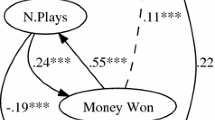Abstract
Understanding the impact of EGM Jackpots on gambling intensity may allow targeted strategies to be implemented that facilitate harm minimisation by acting to reduce losses of gamblers who play frequently, while maintaining the enjoyment and excitement of potential jackpots. The current study investigated the influences of Hidden and Mystery Jackpots on EGM gambling intensity. In a Hidden Jackpot, the prize value is not shown to the player, although the existence of a jackpot prize is advertised. In a Mystery Jackpot, the jackpot triggering state of the machine is unknown to players. One hundred and seven volunteers (males = 49, females = 58) played a laptop-simulated EGM with a starting $20 real-money stake and a chance to win a Jackpot ($500). Participants played for either a Hidden or Known Jackpot Value, with either a Mystery or Known winning symbol combination in a crossed design. Lastly, a control condition with no jackpot was included. Gambling intensity (speed of bets, persistence) was greater when the Jackpot value was unknown, especially when a winning-symbol combination suggested that a win was possible. While there is no evidence in the present investigation to suggest that Hidden or Mystery jackpots contribute to greater player enjoyment, there is some evidence to suggest a marginal positive contribution of hidden jackpots to risky playing behaviour.




Similar content being viewed by others
References
Anderson, G., & Brown, R. I. F. (1984). Real and laboratory gambling, sensation-seeking and arousal. British Journal of Psychology, 75(3), 401–410.
Binde, P. (2007). Gambling and religion: Histories of concord and conflict. Journal of Gambling Issues, 20, 145–165. doi:10.4309/jgi.2007.20.4.
Blanchard, E. B., Wulfert, E., Freidenberg, B. M., & Malta, L. S. (2000). Psychophysiological assessment of compulsive gamblers’ arousal to gambling cues: A pilot study. Applied psychophysiology and biofeedback, 25(3), 155–165. doi:10.1023/a:1009550724836.
Browne, M., Langham, E., Rockloff, M. J., Li, E., Donaldson, P., & Goodwin, B. (2014). EGM jackpots and player behaviour: An in-venue shadowing study. Journal of Gambling Studies, 1–20. doi:10.1007/s10899-014-9485-y.
Clark, L., Crooks, B., Clarke, R., Aitken, M. R. F., & Dunn, B. D. (2012). Physiological responses to near-miss outcomes and personal control during simulated gambling. Journal of gambling studies/co-sponsored by the National Council on Problem Gambling and Institute for the Study of Gambling and Commercial Gaming, 28(1), 123–137. doi:10.1007/s10899-011-9247-z.
Custer, R. L., & Milt, H. (1985). When luck runs out: Help for compulsive gamblers and their families. New York: Facts on File.
Griffiths, M. (1991). Psychobiology of the near-miss in fruit machine gambling. The Journal of Psychology, 125(3), 347.
Griffiths, M. (1993). Fruit machine gambling: The importance of structural characteristics. Journal of Gambling Studies, 9(2), 101–120. doi:10.1007/bf01014863.
Griffiths, M., & Wood, R. (2001). The psychology of lottery gambling. International Gambling Studies, 1(1), 27–45. doi:10.1080/14459800108732286.
Ladouceur, R., Sevigny, S., Blaszczynski, A., O’Connor, K., & Lavoie, M. E. (2003). Video lottery: Winning expectancies and arousal. Addiction, 98(6), 733. doi:10.1046/j.1360-0443.2003.00412.x.
Langer, E. J. (1975). The illusion of control. Journal of Personality and Social Psychology, 32(2), 311.
McPherson, J. (2007). Beating the odds: The complete dictionary of gambling and games of chance. Docklands, VIC: Geoff Slattery Publishing. ISBN: 9780980346619
Nyman, J. A., Welte, J. W., & Dowd, B. E. (2008). Something for nothing: A model of gambling behavior. The Journal of Socio-Economics, 37(6), 2492–2504.
O’Connor, J., & Dickerson, M. (2003). Definition and measurement of chasing in off-course betting and gaming machine play. Journal of Gambling Studies, 19(4), 359–386.
Productivity Commission. (1999). Australia’s gambling industries: Inquiry report. Commonwealth of Australia.
Rockloff, M. J., Donaldson, P., & Browne, M. (2014a). Jackpot expiry: An experimental investigation of a new EGM player-protection feature. Journal of Gambling Studies. doi:10.1007/s10899-014-9472-3.
Rockloff, M. J., & Greer, N. (2010). Never smile at a crocodile: Betting on electronic gaming machines is intensified by reptile-induced arousal. Journal of Gambling Studies. doi:10.1007/s10899-009-9174-4.
Rockloff, M. J., & Hing, N. (2013). The impact of jackpots on EGM Gambling Behavior: A Review. Journal of Gambling Studies, 29(4), 775–790. doi:10.1007/s10899-012-9336-7.
Rockloff, M. J., Hing, N., Donaldson, P., Li, E., Browne, M., & Langham, E. (2014b). The impact of electronic gaming machine jackpots on gambling behaviour. Melbourne, VIC: Gambling Research Australia.
SurveyMonkey [Computer Software]. (1999). Portland, Oregon, USA.
Wood, R. T., Griffiths, M. D., Chappell, D., & Davies, M. N. (2004). The structural characteristics of video games: A psycho-structural analysis. CyberPsychology and Behavior, 7(1), 1–10.
Wulfert, E., Roland, B. D., Hartley, J., Wang, N., & Franco, C. (2005). Heart rate arousal and excitement in gambling: Winners versus losers. Psychology of Addictive Behaviors, 19(3), 311–316. doi:10.1037/0893-164x.19.3.311.
Acknowledgments
This research was funded by a grant from Gambling Research Australia: a partnership between Commonwealth, State and Territory Governments.
Author information
Authors and Affiliations
Corresponding author
Ethics declarations
Conflicts of interest
No conflicts of interest are declared.
Ethical Standards
All procedures performed in studies involving human participants were in accordance with the ethical standards of the institutional and/or national research committee and with the 1964 Helsinki declaration and its later amendments or comparable ethical standards.
Additional information
Phillip Donaldson: Deceased.
Rights and permissions
About this article
Cite this article
Donaldson, P., Langham, E., Rockloff, M.J. et al. Veiled EGM Jackpots: The Effects of Hidden and Mystery Jackpots on Gambling Intensity. J Gambl Stud 32, 487–498 (2016). https://doi.org/10.1007/s10899-015-9566-6
Published:
Issue Date:
DOI: https://doi.org/10.1007/s10899-015-9566-6




